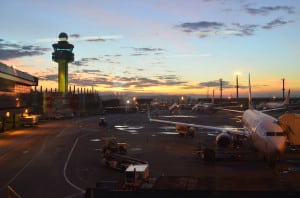[Via Satellite 04-08-2015] Brastrading, an infrastructure-engineering firm with roots in Brazil, is building out an In-Flight Connectivity (IFC) service that could one day cover the entire continent of South America. The company took the lease on a Ka-band package on the Eutelsat 3B satellite, which launched in May 2014, gaining access to an uplink beam and four fully steerable downlink beams. According to Brastrading CEO Wagner Moura, IFC conversations with potential customers have already started, and a number of Brazilian and Latin American airlines are negotiating service agreements.
“Almost immediately one of the applications that jumped out with people asking us if we were interested in providing the bandwidth was aviation,” Moura told Via Satellite.
Brastrading started as a trading company in Brazil, leveraging expertise in navigating the country’s regulations for customers that desired to import goods. Over time the company started working with telecommunications equipment such as microwave, cellular and VSAT. Now, having access to satellite capacity, the company hopes to become a regional provider for IFC.
“Our focus has been on delivering high volumes of bandwidth at low cost to the airlines and, by extension, low cost to the passengers in the Brazilian market initially. Then [we are] planning on expanding to the rest of Latin America in 2017-2018 with new Ka-band capacity that would cover effectively South America from the far south all the way through to being able to handover to Ka-band aviation service in the United States with ViaSat,” said Moura.
The global IFC business has experienced a tremendous level of interest recently, resulting in an influx of new entrants as well as an increase in investment from existing players. Panasonic Avionics has made several large capacity purchases from Eutelsat and Intelsat for Ku-band capacity, and in March 2015 Global Eagle Entertainment (GEE) signed capacity agreements with SES on three satellites. Furthermore, last year Gogo unveiled 2Ku, SmartSky announced a U.S. Air-to-Ground (ATG) network, and Inmarsat detailed a hybrid European satellite-ATG system. But with all this new interest, Comsys Senior Consultant Simon Bull is concerned that the market could be getting too crowded.
“As IFC gradually takes hold, this undoubtedly means more people doing it; but I think something that local providers don’t immediately understand is the level of commitment and investment they are going to have to make to actually get their equipment certified for aircraft, and just what it takes to get that equipment on an aircraft. Even the larger international players have to go through quite a lot of hoops to make that work. It’s not just the case of mounting a low-profile antenna on an aircraft. It’s not just that simple,” Bull told Via Satellite.
This is perhaps best evidenced by AT&T’s withdraw from the IFC game last year, having previously intending to build a large ATG network across the U.S. But while IFC may be getting a bit crowded as a market, Moura is confident that opportunity abounds — particularly in Brazil, being one of the largest countries by geography and population.
“The short-haul market in Brazil between Rio de Janeiro, Sao Paulo, Campinas, Brasilia, Belo Horizonte, all shuttle services and then a host of the coastal cities in the south, next to Western Europe or the Eastern United States — these are the highest volume air corridors in the world,” he explained. “There are something on the order of 800 flights a day between Rio de Janeiro, Sao Paulo and Campinas. There is quite a high volume of flight traffic in that area. We cover it optimally with large amounts of bandwidth and we can easily service 50 to 60 aircraft simultaneously.”
While Bull remains circumspect regarding the quantity of new entrants, he agrees there is a sizeable opportunity in IFC, particularly as airlines ramp up their adoption.
“There are so many niche markets within the satellite industry; what we see at the start of something, once a few key customers take on the service and they gain a competitive advantage with that service, it quickly reaches a point where the others have no choice but to follow whether they believe in it or not. They start believing it because otherwise they don’t get the customers,” he said.
Brastrading plans to invest significantly in Ka-band capacity to cover Latin America. Moura said the company ruled out Ku band due to underwhelming bandwidth efficiency with small antennas. Moura is also not in favor of ATG, arguing that backhaul requirements on the ground would severely inhibit the quality of such a service in Brazil. Building an ATG network would also be a challenge given the country’s topography.
“The real blocking-issue over time in all this is global availability of Ka band. It is regionally distributed so we are waiting for more capacity. That is one of the reasons we are going to invest in satellites to provide Ka capacity in Latin America, not just selected areas but everywhere where it is germane,” he said.
Using Ka band, Brastrading aims for a starting service of 6 to 8 Mbps to each passenger’s seat. Over time that speed could increase. Mauro described High Throughput Satellites (HTS) as a “game changer” for aviation and several other mobility markets. Machine-to-Machine (M2M) communications within aviation are also a focus for the company.
Bull expects regional players could play a significant role in IFC. Government aviation customers, in particular, could look to national operators to connect their aircraft. He added that larger international players face challenges of their own when trying to expand, and could look to regional players for partnerships or acquisitions.
The post Brastrading Building Regional In-Flight Connectivity Service for Latin America appeared first on Via Satellite.
